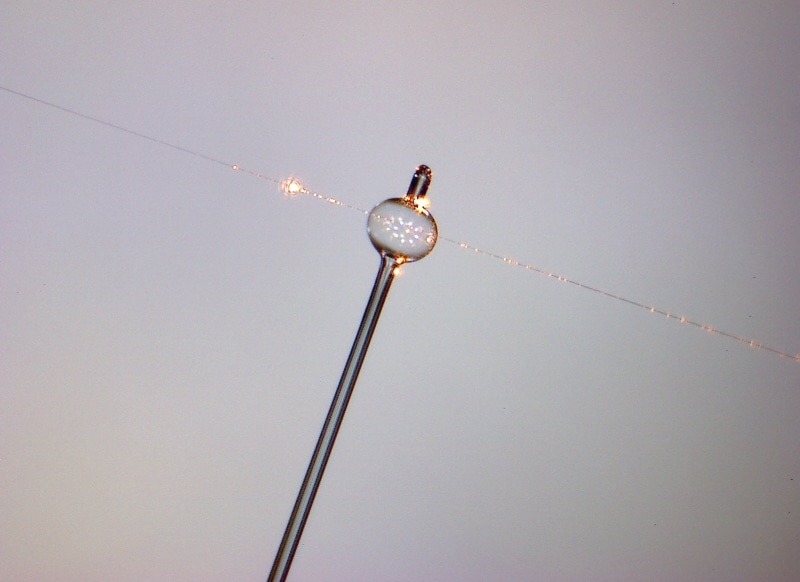Jul 12 2018
Scientists at the Okinawa Institute of Science and Technology Graduate University (OIST) have developed technology that is in fact throwing light on certain smallest particles to detect their presence — and it is developed from tiny glass bubbles.
 A magnified photograph of a glass Whispering Gallery Resonator. The bubble is extremely small, less than the width of a human hair. (Image credit: OIST)
A magnified photograph of a glass Whispering Gallery Resonator. The bubble is extremely small, less than the width of a human hair. (Image credit: OIST)
The technology is based on a unique physical phenomenon called the “whispering gallery,” described by physicist Lord Rayleigh (John William Strutt) in 1878 and named after an acoustic effect inside the dome of St Paul’s Cathedral in London. It was possible to clearly hear the whispers made at one side of the circular gallery at the opposite side. This is due to the travel of sound waves along the walls of the dome to the other side. This effect can be reproduced by light in a tiny glass sphere with a width just equal to the breadth a strand of hair, known as a Whispering Gallery Resonator (WGR).
Upon shining light into the sphere, it bounces around the inner surface again and again, forming an optical carousel. Photons that bounce along the inner surface of the tiny sphere can end up traveling for long distances, as long as 100 m at times. However, every time a photon gets bounced off the surface of the sphere, a small amount of light escapes. This leaking light forms a kind of aura around the sphere, called as an evanescent light field.
When nanoparticles enter the range of this field, its wavelength is distorted by them, thus effectively altering its color. Researchers can monitor these changes in color and use the WGRs as a sensor; earlier, different research teams used them to detect individual virus particles in solution, for instance. However, researchers at OIST’s Light-Matter Interactions Unit observed that enhancements to prior work can be made to develop even more sensitive designs. The research has been reported in the journal Optica.
Currently, Dr Jonathan Ward is using WGRs to more efficiently detect minute particles like never before. The WGRs developed by them are hollow glass bubbles and not balls, explained Dr Ward. “We heated a small glass tube with a laser and had air blown down it—it’s a lot like traditional glass blowing.” When the air is blown down the heated glass tube, a spherical chamber with the ability to support the sensitive light field is formed. The most obvious variation between a blown glass ornament and these precision instruments is the scale: the size of the glass bubbles can be as low as 100 μm — a fraction of a millimeter in width. Their size renders them fragile to handle; however, they are also malleable.
Dr Ward worked from theoretical models and demonstrated that it is possible to increase the size of the light field with the help of a thin spherical shell (or a bubble) rather than a solid sphere. The range in which particles can be detected is increased when a bigger field is used, thereby increasing the sensor’s efficacy.
We knew we had the techniques and the materials to fabricate the resonator. Next we had to demonstrate that it could outperform the current types used for particle detection.
Dr Ward
The researchers devised a relatively simple test to prove their concept. A liquid solution that contains tiny particles of polystyrene was filled into the new bubble design, and light was made to shine along a glass filament to produce a light field in its liquid interior. Particles that moved within the range of the light field produced evident shifts in the wavelength that were considerably more pronounced compared to those observed while using a standard spherical WGR.
As the researchers now have a more effective tool at hand, their next challenge would be to find applications for it. Gaining knowledge on the changes brought about by different materials to the light field would enable Dr Ward to identify and target them, and even manipulate their behavior.
In spite of their fragility, these new variants of WGRs can be easily produced and can be safely transported in tailor-made cases. This suggests that it would be possible to use these sensors in a broad range of fields, such as detecting pollution by testing for toxic molecules in water, or detecting blood-borne viruses in highly rural areas where healthcare may be limited.
We’re always pushing to get even more sensitivity and find the smallest particle this sensor can detect. We want to push our detection to the physical limits.
Dr Ward